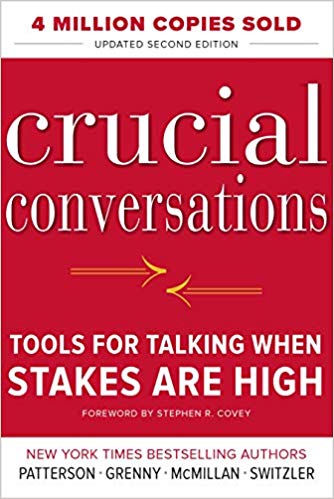

This article is an excerpt from the Shortform summary of "Crucial Conversations" by Kerry Patterson. Shortform has the world's best summaries of books you should be reading.
Like this article? Sign up for a free trial here .
What does it mean to have a healthy dialogue? Do you have to keep the dialogue open to have successful communication?
In order to have a healthy dialogue, you have to recognize the need for a crucial conversation, and how to make it happen. A healthy dialogue makes it all possible.
Why Should You Maintain a Healthy Dialogue?
What does it mean to have a healthy dialogue? How do you keep an open dialogue to ensure your crucial conversation is open-minded and fair?
Common Crucial Conversations
There are many crucial conversation topics that, if mishandled, can lead to disastrous results in your personal life or at work. They include:
- Personal: Ending a relationship, asking a roommate to move out, resolving a custody issue with an ex-spouse, dealing with a troubled teen, confronting a loved one about problem behavior.
- Work: Confronting a coworker about a problem, giving the boss critical feedback, critiquing a colleague’s work, presenting a negative performance review, confronting a team member who isn’t following through, confronting a coworker who has poor hygiene.
Making Conversations Work
For a healthy dialogue that leads to successful crucial conversations, we must:
- Share our unique information.
- Get others to share their information.
- Make it safe to discuss controversial matters.
- Amass a shared pool of information.
Fortunately, dialogue skills are learnable. When you develop the skills to master crucial conversations you can transform them from upsetting events to productive discussions when you learn to keep an open dialogue.
The rest of the book explains how you can create conditions conducive to dialogue. You’ll learn to:
- Identify your conversation style when stressed.
- Control your emotions.
- Watch for and catch dialogue-ending problems before they get out of hand.
- Create safe conditions for dialogue.
- Express feedback respectfully.
- Be persuasive, not off-putting.
- Encourage people to share their views.
- Transition from discussion to action.
How to Have a Healthy Dialogue: Know Your Heart
Learning healthy dialogue skills starts with diligent self-examination because if you don’t understand yourself, you can’t be fully effective at dialogue.
In crucial conversations, you’ll revert to tactics you grew up with (debate, silent treatment, manipulation, etc.). You need to understand your tendencies in order to counteract them and learn new skills, and to keep an open dialogue.
You also need to be able to see how you’re contributing to the problems you’re experiencing. In disagreements, it’s human nature to focus on what you think someone else is doing wrong. But when you focus on blaming or finding fault, you lose track of what you really want, to your detriment.
For example, two children who get into a fight over who should be first to use the bathroom forgot their objective (using the bathroom) when they became focused on winning the argument. As a result, they prolonged their misery.
It’s important to begin high-risk discussions with the heart (with the right motives) and stay focused no matter what happens.
You do this by making two heart-based assumptions:
- First, you must know what you want, and despite temptations, stick with your goals.
- Second, don’t make fool’s choices (either/or choices). Rather than choosing between fight and flight, realize that dialogue is always an option.
Example: Greta the CEO
Here’s an example of how switching your motives unconsciously due to emotion can affect your ability to stay in productive conversation.
Greta, a corporate CEO, has been trying for months to get her top managers to cut costs, but they’ve been dragging their feet. During a crucial conversation on the problem, a manager explains frankly why progress hasn’t been made: Greta herself is the roadblock.
The manager explains that while Greta says she wants her team to cut expenses, everyone knows that she’s spending money building and decorating a new office for herself, which comes across as hypocritical. Greta responds to the manager’s honesty by tensing up, looking as if she is under attack, and starting to point a finger. Her motive has changed: She is no longer focused on cost-cutting but on reasserting her authority or worse.
When you come under pressure in a discussion, if you’re not alert to our emotions, you may forget your original purpose (understanding and solving a problem by creating a shared pool of information) and switch to winning, punishing, or keeping the peace.
- Winning: Winning is praised in sports, movies, and TV. We learn at an early age that we have to outdo/beat our fellow students, and get the teacher’s attention with the right answer. But the desire to win short-circuits dialogue. You start with the goal of resolving a problem, but as soon as someone challenges you, you switch your purpose to winning.
- Punishing. As your anger at being challenged builds, you may want to discredit the other person or put them in their place, again straying from your original purpose.
- Keeping the peace: When a conversation gets uncomfortable, you may withdraw or go quiet, choosing peace over further conflict. But you likely won’t avoid a negative result in the end. For example, had no one spoken up at Greta’s meeting for fear of conflict, the results would have been negative nonetheless: She wouldn’t have learned the real issue, and her managers would have continued to resist cutting costs.
Here’s how to stay focused on your original goals/motives for the conversation, and avoid getting sidetracked by a desire to win or by some other motive: Focus on what you really want, and refuse the fool’s choice to have a healthy dialogue.
Remember What You Really Want to Have a Healthy Dialogue
Part of a healthy dialogue is being honest with yourself. In order to do that, you need to ensure that you’re keeping track of yourself and how you’ree communication.
Reboot
Stopping and asking yourself a question can redirect your thinking when heat starts to build — for instance when someone strongly disagrees with you. Stop and remind yourself of what you really want. Then ask whether you’re starting to change your goal to something else. What you’re feeling and doing are clues. Under the influence of adrenaline, your motives change without conscious thought.
Once you zero in on your shifting motives you can choose to change them. Remind yourself of your original purpose (what you want from the conversation for yourself and others), then consider how you should behave to achieve your purpose. Ask yourself, “how should I behave, if I actually wanted my results?”
Stay on Track
Taking the wrong path can be tempting. You may try to pick a fight, or succumb to your ingrained desire to win. Again, remind yourself of what you’re trying to accomplish in the conversation, and stay on track.
Be Aware of Your Body
Under pressure, your body reacts. If you catch this happening, you can switch your brain from a fight or flight response to problem-solving mode. When you pose a demanding question, your body sends blood to the brain to help you think and away from the parts of the body that prep for fight or flight. This isn’t helpful if you want to keep an open dialogue.
Asking questions about what you want reminds you of your goal and resets your brain in a way that helps keep you focused on dialogue.
Example: Greta the CEO (cont’d)
In the preceding example of the uncomfortable managers’ meeting, here’s what happened. Greta dodged the bullet by stopping her initial anger and remembering what she really wanted from the conversation: Her goal was to encourage the managers to embrace the cost-reduction efforts.
When she realized that the barrier was the staff’s belief that she was a hypocrite, she went from feeling angry to being grateful that by speaking up her manager had given her the opportunity to address the problem. Instead of expressing anger, she expressed openness and interest.
She explained that her new office was part of a marketing effort to create a different image.
However, she admitted that she hadn’t paid enough attention to the cost. A candid conversation followed and they agreed to move ahead with the building project, but to cut costs in half.
Because Greta remained focused on her motive instead of being derailed by anger, she got the results (cost reductions) she was seeking.
You can have a healthy dialogue by practicing the principles of crucial conversations. It’s important to maintain a healthy dialogue to foster healthy communication and relationships.

———End of Preview———
Like what you just read? Read the rest of the world's best summary of Kerry Patterson's "Crucial Conversations" at Shortform .
Here's what you'll find in our full Crucial Conversations summary :
- How to approach an argument without getting mad
- The mistakes most people make when trying to listen to someone else
- How to come up with win-win solutions that make everyone happy






